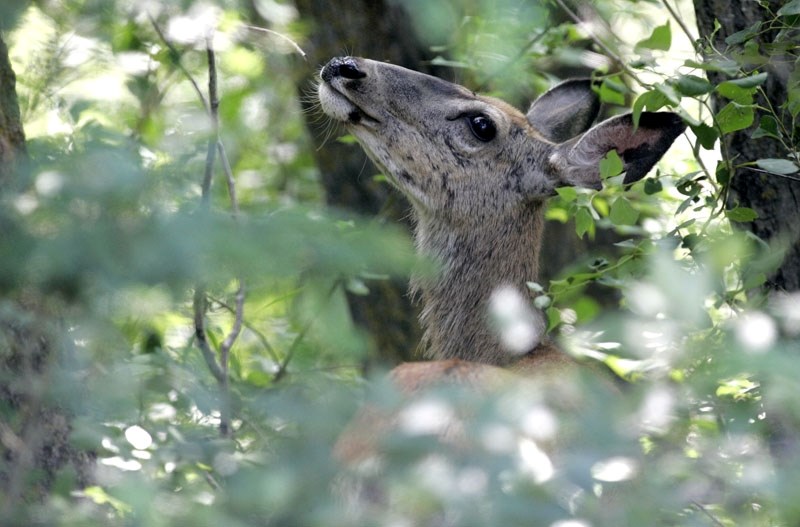All sorts of creatures get labelled as pests, and some of them deserve the label. The key to dealing with the neighbour’s cat messing with your garden or a deer or rabbits invading your vegetable patch is knowing what you can control and being proactive rather than reactive.
Jim Hole, of Hole’s Greenhouses, says talking to a neighbour about an errant cat relieving itself in your garden is probably a starting point, but if you don’t get co-operation, he suggests placing some catnip in a place where you can tolerate the cat’s behaviour. He also says that there are cat repellents that can be attached to plants.
“Cat repellents are another tool in the tool box. They’re not perfect, but they all help. If you’re going to have an open door to the cats in your yard, that’s where the problem starts, but if you have things that are going to shift them in a different direction, that’s all going to help.”
Fencing is the standard approach to keeping animals like deer or moose from enjoying your property.
“You just can’t have animals chewing everything up,” Hole says. “The most effective approach to these big things is fences.” But there is also a deer repellent call Bobbex that deer hate the smell of. It can be applied in the fall and winter as a deterrent, as well. He advises wrapping trees because voles and mice chew up trees during the winter.
Hole says aggravation can be reduced if people foresee problems before they arrive.
“If you look at pest control, people tend to react, rather than be proactive on things. That’s the bulk of my day. People are coming in with a major problem and they want a solution. I always equate it to teeth. You brush your teeth every single day because you want to prevent cavities. You do that as a preventative.
“That’s kind of the situation in dealing with pests in the backyard. You’ve got to be ahead of the curve and anticipate that these things are going to happen. After the fact, there aren’t a lot of solutions.”
If you have a history of porcupines in the area, for example, wrapping tree trunks with about 40-inch wide stove pipe will prevent them from climbing up the tree in the winter. They can climb mesh, so something that keeps them from getting a grip will protect your trees.
“If you have a history in the neighbourhood of certain pests, don’t wait for them to come. Understand that they’re going to come, and just get the treatments that are going to prevent the pests from coming in, or you’re going to get them at an early stage where they’re much easier to control.”
Any animal will follow the path of least resistance, so making your own yard inconvenient will mean an animal like a rabbit will look for easier pickings in a neighbour’s yard if it’s faced with a fence in yours.
Most mammal damage is done in the late winter and early spring, Hole says, but there are issues in the summer as well.
“One thing that has proven to be popular is this lightweight fabric that covers crops. It’s a very lightweight woven fabric that you can put over top of your plants. It’s particularly good for insect pests, but it also works for cats because they can’t get through the fabric.”
Hole says you have to actually know the insect pest you’re dealing with before you select a treatment.
“You have to know what’s a pest and what’s not a pest. If you don’t know that, you can use the wrong product, and it’ll do absolutely nothing.”
He’s had customers bring a bug to the greenhouse, and he has to explain that the bug is actually eating the pests in the garden; it isn’t a pest itself.
There are the traditional insecticides available, of course, but people’s attitude toward chemical sprays is changing. There are more “bio-controls” on the market that eliminate concerns about chemical hazards.
“In past years, people were more inclined to bring out the big guns and spray everything. There are fewer products like that available to homeowners. And there’s also a desire to minimize the negative effects on the backyard ecosystem. If you’re eating the product, you want to know what’s going on.”
Learning to live with a certain amount of insect life may be the more balanced approach. Hole’s mother, Lois Hole, gave him some advice.
“Mom used to say one for you and one for the bugs when she planted stuff. There’s a lot of wisdom in that. I get questions about how to ‘eliminate’ something, as if there’s a permanent solution. The operative word should be ‘control,’ strike the right balance there.”
But sometimes the pests just win the battle.
“I know a lady in Grande Prairie who had rabbits come in her yard. And then she had porcupines, and then she had deer, and then she had elk, and then she had moose, and finally she had bison come through. By that point she gave up on the garden and decided she had to live with whatever happens.”




